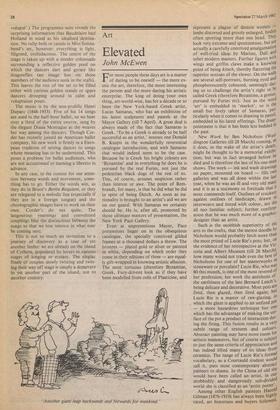Art
Elevated
John McEwen
For most people these days art is a matter of daring to be oneself — the more ex- otic the art, therefore, the more interesting the person and the more daring his artistic enterprise. The king of doing your own thing, art-world-wise, has for a decade or so been the New York-based Greek artist, Lucas Samaras, who has an exhibition of his latest sculptures and pastels at the Mayor Gallery (till 7 April). A great deal is always made of the fact that Samaras is Greek. `To be a Greek is already to be half successful as an artist,' intones one Donald B. Kuspit in the wonderfully reverential catalogue introduction, and with Samaras that would indeed seem to be the case. Because he is Greek his bright colours are `Byzantine' and in everything he does he is pursued by the real Furies, not just the pedestrian black dogs of the rest of us. This, of course, arouses suspicion rather than interest or awe. The point of Rem- brandt, for many, is that he did what he did in spite of being Dutch. As soon as na- tionality is brought to an artist's aid we are on our guard. With Samaras we certainly should be. He is, after all, promoted by those ultimate masters of presentation, the New York Pace Gallery.
Even at unpretentious Mayor, Pace pretensions linger on in the obsequious catalogue, the specially contrived gilded frames at a thousand dollars a throw. The bronzes — plated gold or silver or painted in white, depending on which order they come in their editions of three — are equal- ly gift-wrapped in knowing artistic allusion. The most tortuous (therefore Byzantine, Greek, Fury-driven) look as if they have been modelled from coils of Plasticine, and represent a plague of demon women — limbs distorted and grossly enlarged, bodies often sporting more than one head. They look very extreme and spontaneous, but are actually a carefully contrived amalgamation of well-tried ideas by Matisse, Dali and other modern masters. Further figures with
wings and griffin claws make a knowing point of being kitsch, thereby flattering the superior notions of the viewer. On the walls are several self-portraits, burning eyed and phosphorescently coloured, seemingly dar- ing us to challenge the artist's right to be called Greek (therefore Byzantine, a genius, pursued by Furies etc). Just as the word `art' is embedded in `market', so is the small but lively talent of Samaras, par- ticularly when it comes to drawing in pastel, embedded in his latest offerings. The disa13- pointment is that it has been less bedded In the past. New Work by Ben Nicholson (Wad- dington Galleries till 28 March) coming, as it does, in the wake of the artist's death, might be thought to be a memorial exhibl" tion; but was in fact arranged before he died and is therefore the last of his one-man shows. The work — ink and wash drawings on paper, mounted on board — fills two galleries and was all done within the last year, when he was an ill and very old marl; and it is as a testimony to fortitude that It most commends itself. Outlines of crockerY against outlines of landscape, drawn to interweave and tinted with colour, are the all too familiar subject; further confirm- ation that he was much more of a graphic- designer than an artist. Such is the snobbish superiority of the arts to the crafts, that the merest doodle by Nicholson would probably fetch more than the most prized of Lucie Rie's pots; but, on the evidence of her retrospective at the Vic- toria and Albert Museum (till 28 March), how many would not trade even the best of Nicholsons for one of her masterworks in stoneware or porcelain? Lucie Rie, who Was 80 this month, is one of the most revered of her profession; her work the antithesis of the earthiness of the late Bernard Leach's, being delicate and decorative. Most pots are fired, then glazed, then fired again; but Lucie Rie is a master of raw-glazing, 111 which the glaze is applied to an unfired pot — a more hazardous technique but one which has the advantage of making the sur- face of the pot a product of interaction dur- ing the firing. This fusion results in a very subtle range of textures and colours. Abstract painting may have more room for artistic manoeuvre, but of course is subject to just the same criteria of appreciation and has indeed lifted many of its ideas from ceramics. The range of Lucie Rie's formal vocabulary, as a Courtauld student would call it, puts most contemporary abstract painters to shame. In the China of old she would have been called an artist, in our, snobbishly and dangerously sub-divided world she is classified as an `artist potter
Among other English painters Harold Gilman (1876-1919) has always been highly rated, art historians and buyers followed, and now we have a full and overdue retrospective (Royal Academy till 4 April). Application of paint comes first with Gilman, the subject the paint describes, se- cond. His use of paint — the thickness, pliability, colours and mixes of it — is his interest, his subjects — lodging-house ladies, bedrooms, views, meals — are repetitive and unspectacular. By the stan- dards of the artists of his inspiration from Velasquez to (much more crucially) Van Cogh — Gilman is a bit dull too; but he is a good, solid performer nonetheless. If he had not died at 43 . . .? But he did, when giving Sickert the best run for his money of all the Camden Town Group.





































 Previous page
Previous page